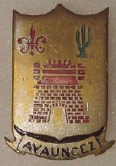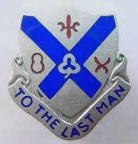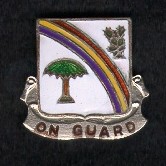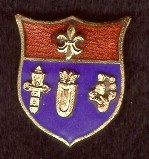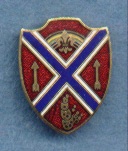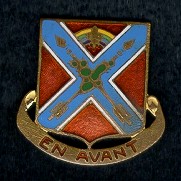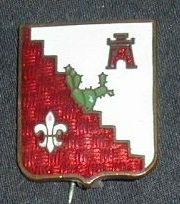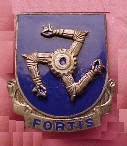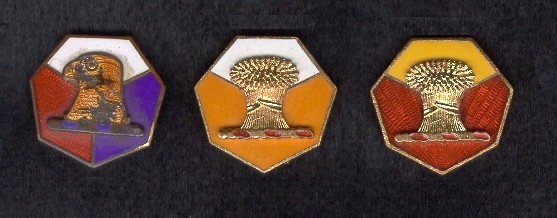THE
STORY OF THE 34th INFANTRY DIVISION
~~~~~ Part 1 ~~~~~
IRELAND
• Beginning
[1941]
The entry of the United States into the war found the 34th Infantry
Division
already organized. Formed from the National Guard of Iowa, Minnesota,
and
North and South Dakota, the Division was inducted into Federal service
on 10 February 1941
and, after basic training at Camp Claiborne, took part in the
Louisiana
maneuvers. Following the attack on Pearl Harbor, certain units were
dispatched
to key places in the southern states for security purposes, but hardly
had they settled down to their first war job when they were
ordered
to Fort Dix, New Jersey, for the War Department had selected the
34th to be the first American Division to go to the European
Theater
of War in World War II. The destination was Northern
Ireland.
{The Louisiana Maneuvers were large scale war games on the size of an
Army.}
The Commanding General,with a small staff group and some elements
of the Division, left for overseas almost at once to prepare for
the main body. During their absence, and on practically no notice,
the
Division rapidly streamlined itself from a square to a triangular
Division,
which meant, unfortunately, that several units had to leave the
Division.
There was little time for regrets, though, for in three waves
between
15 January 1942 and 13 May 1942 the Division shipped out, so that
by the end of May the whole formation had concentrated in Ulster.
The Division at once began a training program for small units
which,
especially as it was being executed overseas, had rather more
urgency
than the Louisiana maneuvers.
The country of Northern Ireland is wild and wet. Jagged hills and bare
moors are dotted with peat bogs and cut by brown mountain
torrents.
The Division soon became accustomed to the difficulties of the
cross-country
movements which later were to form part of their daily existence
in combat. Almost as soon as the Division had arrived in Ireland
a call was made for volunteers to create the 1st
Ranger Battalion, which may be said to
have had its origins in the 34th Infantry Division. In order to
create
team spirit and cooperation with our British Allies, a number of
exercises involving the services of both nations were held. Training
for
combat was intensified after Major General Charles W. Ryder
assumed
command of the Division on 12 June 1942,
for the General was certain that more active duties than
garrisoning
a base lay ahead.
ALGIERS
• Pretending
[1942]
In the early part of August confidential orders were received to move
the
168th Regimental Combat Team from Ireland to Scotland in preparation
for
an undisclosed combat mission. While in Scotland the 168th RCT
underwent
rugged training for amphibious and mountain warfare. A small inkling of
the type of operation which lay in the offing was obtained when
volunteers
were requested for No. 1 and No. 6 Commando, British units which
specialize
in amphibious raids and whose toughness is a byword in the Allied
services
As training progressed, further orders were received from the High
Command
to constitute a planning group which was to move to London on an
extremely
secret mission. It was in London that it first became known that
elements
of the 34th Infantry Division had been selected to take a large part in
the first big Allied offensive of the war - the landing in North
Africa.
The mission was to seize the port of Algiers and to insure that it was
kept open for the supply of an Allied army which, moving rapidly
eastward,
was to occupy Tunisia, taking Rommel's Afrika Corps in the rear.
The Allied force which General Ryder was to command was given the name
"Eastern Assault Force" and was to land near Algiers at precisely the
same
hour when two other Allied task forces hit the beaches near Oran and Casablanca.
It is not of great importance here to study the details of this
gigantic
operation; it is enough to say that the Eastern Assault Force arrived
off
Algiers at the appointed time, 0100 hours on 8 November 1942. Due to
certain
errors, not all of the assault infantry waves were put ashore at the
right
places. In the case of the 168th Infantry a delay of several hours was
caused by the landing of a battalion 17 miles away from its designated
beach. Nevertheless, so thorough had been the briefing of all ranks on
the situation and mission that the heights overlooking Algiers were
under
our control less than 12 hours after the first landing craft scraped
upon
the beach. The 3rd Battalion, 135th Infantry, had joined the expedition
at almost the last minute, being given the task of landing from two
destroyers
after they had smashed the boom guarding the entrance to the harbor.
Although
a gallant attempt was made to put this plan into execution the boom
proved
a more difficult proposition than was first thought and before the
leading
destroyer could bring up alongside the mole, French searchlights and
guns
had been alerted and severe damage was inflicted upon the two small
ships.
The infantry who managed to get ashore were opposed by Senegalese
troops
and French tanks - more than a match for the Americans who had only
small
arms. When our troops had fired all their ammunition their commander
surrendered
to prevent further bloodshed.
Meanwhile, a second American Combat Team and a British Brigade seized
important
airfields south of Algiers while
the 168th Infantry had patrols in the
southwestern outskirts of the city. Throughout the whole of this
skirmishing,
negotiations were going on between General Ryder, as the Allied
representative,
and General Juin, French commander.
On the morning of 9 November, a little more than 24 hours after the
assault
waves touched down, a conference was held in the main fort of Algiers
and
an armistice arranged which came into final effect on 11 November.
<>FIRST
DAYS
IN TUNISIA Skirmishing
The campaign in North
Africa began with several days of combat against the Vichy French army
and navy. Then came a period of organizing under the Britis high
command. By January 1943, German troops had landed
re-inforcements in Tunisia and the Americans first entered combat
against the German Wehrmacht troops.
After the German Army in North Africa surrendered, the
34th Division stopped to rest and re-organize. General Patton
lead the 7th Army in the invasion of Sicily, while the 34th prepared
for fighting on the mainland of Italy..
Also of
interest is that on 19 November 1942, the 175th Field Artillery
Battalion was assigned to support the British 78th Division and entered
combat at Medjez-el-Bab, Tunisia. This was the first American
unit to enter combat against the German army.
OMITTED
PORTION OF HISTORY RELATED TO NORTH AFRICA
|
TRAINING
FOR EUROPE – Preparing
[1943]
The fighting in Tunisia came to an end on 13 May 1943. The
Germans
had suffered a major defeat. Many of the finest Allied troops had been
required to beat them yet the war was so exacting that there was little
time for self-congratulation. Almost at once, preparations were begun
for
the conquest of Sicily, and the 34th Division received the
vital,
if not very exciting, job of helping the invading troops to make a
smooth
departure from Africa.
The 34th were the "housekeepers" for Sicily. Several provisional truck
companies were organized using vehicles, drivers and mechanics from the
Field Artillery Battalions of the Division who, day in and day out,
hauled
gasoline to the airfields in an effort to slake the thirst of the
bombers
paving the way for the landings. The Infantry Regiments set up staging
camps for the assaulting troops, furnished the cooks and KPs - yes, and
dug the latrines. The task was not pleasant, but it was done.
Not all was work though. Our French Allies, whose small, poorly
equipped
Army had fought so magnificently at our side during the campaign, had
decided
upon a Victory March through the streets of Tunis. The U.S. troops who
had taken part in the African fighting were represented on this
occasion
by the 135th Infantry Regiment who marched past in a solid mass under
the
palms of the Boulevard de Gallieni, to the vigorous applause of the
crowd.
There was no complacency in the Division however. Wise soldiers learn
from
their experience
The Commanding General called for a school to be held in which the
lessons
learned in Tunisia could be studied and broadcast throughout the 34th.
All of the staff and demonstration troops came from the Division
itself,
and they placed great emphasis on the training of small unit leaders
and
on the practical way to do things. After some delays and difficulties
the
school opened near Tebourba in what must have been the hottest olive
grove
in Africa. It was a very serious school - all concerned went there to
get
all they could out of it, for, as the General said in his opening
address,
"We shall fight in Europe, and we shall find there that, in comparison,
the Tunisian Campaign was just a maneuver conducted with ball
ammunition."
In the meantime the troops assembled into dumps much of the vast booty
of war, which the Germans, by their surrender, had let fall into the
hands
of the Allies. The 135th Infantry manned a huge prisoner of war camp
near Bizerte, capable of
handling 10,000 prisoners, which rapidly filled up
as Allied victories in Sicily mounted. The 168th Infantry, not letting
their pride stand in their way, did yeoman service in the Bizerte docks
discharging ships.
After Sicily - the European mainland. A stiff job, in which only
good troops with good training would survive. At the end of July 1943,
the 34th Division handed its housekeeper's apron to other units and
boarded
its trucks and the decrepit French "40 & 8's" for the long and
dusty
ride to Oran. Assigned to Fifth Army,
the 34th went with a will through
the tough, efficient program of the Invasion Training Center, with its
realistic street fighting, its obstacle courses, its live artillery
barrages,
its "ball ammunition". You get out of training only as much as you put
into it - and General Alexander said that he had never seen troops "go
at it" with such spirit. As so often happens, not all the troops were
able
to complete the course, for time was passing - D-Day loomed ever
closer. {Whenever you talk to a Veteran, they always mention
their experiences riding in the "40 & 8" train cars. I don't
know if they crammed 40 soldiers in them but I'm sure the ride was not
pleasant.}
It was during this training program, too, that an important addition
was
made to the infantry strength of the Division. The 34th had been
selected
by the War Department to demonstrate to the world that U.S. citizens of
Japanese descent could fight alongside other Americans in full
confidence
and efficiency. The 100th Infantry
Battalion,
composed almost exclusively of these American "Nisei" mainly from
Hawaii,
was assigned to fill the place of the 2nd Bn 133rd Infantry Regiment.
As
our story is told, we shall see how nobly this experiment succeeded,
for
the Hawaiians' reputation is now a legend, not only in the 133rd
Infantry,
but throughout the World.
SALERNO
- BENEVENTO – Hurrying
The 34th Infantry Division was in Army reserve for the Salerno
operation.
No one knew, when the operation was started, exactly how it would
go - everyone was tensed, alert for anything, plans were as flexible as
possible. To begin with, the 151st Field Artillery Battalion was
detached
from the Division, and landed under command of the 36th
Infantry Division on the Salerno
beaches
on D-Day - 9 September 1943. At once the Battalion was in the thick of
it. German tanks and infantry slashed savagely at the beachhead, trying
to drive it back into the sea. The 105mm howitzers were dragged off
their
landing craft and rushed up the sandy slope to the very perimeter of
the
beach. Firing at maximum rate over open sights the 151st Field
Artillery
decisively smashed the enemy Panzers who drew off but to come again and
again. One battery was overrun by tanks. The gunners coolly withdrew,
deployed
as infantry with their '03 rifles, counter-attacked and recaptured
their
guns. At a time when the entire Salerno enterprise was threatened with
costly failure, the men of the 151st Field Artillery Battalion stuck it
out and won. The Chief of Staff of the 36th Infantry Division said,
"The
beachhead would have been destroyed if it had not been for the early
arrival
of the 151st Battalion thirty minutes before the first counter-attack."
For eight days the Battalion shot it out with the Germans and fired
more
rounds than during the entire Tunisian campaign. {’03 Rifle refers to the Model 1903 bolt-action,
single shot Springfield
rifle
that date back to WW1. These were replaced by the M-1 Garand, an
8-shot semi-automatic rifle.}
The news of this performance filtered back to the Division poised at
the
port of embarkation. So this was Europe!
The 135th and 168th Regimental Combat Teams set sail from Oran for
Naples,
but at once it became clear that the great port would not be taken in
time
to be used for their convoy. It was still not even certain that the
beachhead
would be held. Word was flashed to the 133rd Regimental Combat Team,
still
at Oran, to load their ships - for combat. In less that forty-eight
hours,
working day and night, the 133rd RCT waterproofed all its vehicles,
stored
its equipment not needed for fighting, stripped for action - ready, if
necessary, to make an assault landing to restore the beachhead.
Traveling fast, the 133rd's ships arrived off Salerno a few hours after
the 135th and 168th Combat Teams. These latter troops, since they had
been
ordered to load for landing in a port, found it a slow business to
transfer
themselves, their baggage, their weapons, vehicles and stores to
landing
craft and "ducks" for the choppy passage to the beach. On the other
hand,
the 133rd, loaded and equipped for the task, smoothly disembarked
everything
in twelve hours and formed upon land - ready to go. They did not have
long
to wait.
The situation on shore was roughly this: the German Command, realizing
that its attempts to contain and then to smash the bridgehead had
failed,
had decided to relinquish its hold on the southern portion of the
perimeter
and to swing back to the north, while retaining the high ground north
of
Salerno as a hinge. It would then be possible to form a single front
from
one side of Italy to the other. It was necessary to prevent the Germans
from organizing their defense at their leisure. Higher headquarters
therefore
directed the 34th Division to form a task force consisting of the 133rd
Infantry, 151st Field Artillery Battalion, and attached anti-aircraft,
engineer, medical and reconnaissance troops, together with the
necessary
staff, and to push on as swiftly as possible to block off the enemy
route
of reinforcement between Benevento, sixty miles to the north, and the
battle
area. Once the highway leading south from this town was cut we could
take
the initiative and push on rapidly across the Calore River and take the
fight to the enemy.
Accordingly this task force passed through the 45th Infantry
Division
on
28 September 1943 at S. Angelo di Lombardi and, pressing up Highway 7,
made their first contact with the enemy along the Calore River near the
town of Montemarrano. The
German troops consisted of armored infantry,
self-propelled guns, and engineers in half-tracks from the 26th Panzer
Division - a very efficient organization whose armored
counter-attacks
against the beachhead had proved so nearly fatal.
It was not the Germans' intention at this time to fritter away
resources
by fighting pitched battles at frequent intervals. Instead, their
engineers,
covered by the infantry, demolished every bridge and prepared road
blocks
at awkward points so that our advance could not possibly be as rapid as
would have been desired. Furthermore, in order to discourage any undue
boldness on our part, each U-curve and ledge in this serpentine highway
was covered by fire from high-velocity weapons and small arms,
necessitating
wide out-flanking movements into the hills alongside the road. Great
endurance
was required of our troops since speed was absolutely essential.
By 29 September our troops had occupied the heights west of Chiusano
and it was in taking this objective that the 100th
Infantry Battalion first met the
enemy.
As the advance pressed on to the northwest, Montemiletto was captured
and
by the evening of 1 October advance elements of the 133rd Infantry
reached
the outskirts of Benevento. The next day the town itself was occupied
and
a bridgehead was secured across the Calore River without too much
difficulty
since, due to the speed of our advance, the German engineers had not
had
time to demolish the bridge very thoroughly. While there was a great
gash
in the masonry, the structure was still firm enough for our foot troops
to cross, and when a truck-load of German engineers with a truck-load
of
explosives came back that night they were surprised by our infantry and
were forced to beat a hasty retreat before they could even start
work.
It would be difficult to overestimate the endurance and the
aggressiveness
of troops who, in spite of continuous rain and in the face of delays
caused
by stout enemy resistance, continued to press on and finally forced the
enemy out of a vital road junction and river crossing, making an
advance
of 40 miles in rugged country in five days.
While the 133rd Infantry Task Force was scoring the first of the
Division's
great successes in Europe, the 135th and 168th RCTs devoted themselves
to training in the use of close-combat anti-tank weapons and in
preparing
themselves for the fierce fighting to come. At each successive assembly
area which was occupied in the wake of the rapid drive to Benevento,
not
a moment was lost, for in spite of the vigorous training in Africa, the
ferocity of the combat in Italy had made a deep and startling
impression
on those who had tasted it. Those for whom the experience had yet to
come
wisely devoted all their energies to learning the lessons of other
soldiers'
experience.
With Benevento in our hands, the barrier of the Calore River crossed,
this
sector was handed over to the 45th
Infantry
Division, while the 34th assembled 30
kilometers to the west, preparatory to relieving elements of the 3rd
Infantry Division along the Volturno
River.
VOLTURNO
– Spanning
The {Volturno River}
formed the first large obstacle which the Germans had decided to defend
since the breakout from the beachhead. In the 34th Division sector,
which
was nearly 15 kilometers wide, the stream was swift and in some places
deep enough to cover a man's head, with steep banks overgrown with
shrubbery.
Immediately upon taking over the sector very active patrolling was
begun
in order to discover the best places to cross, the easiest bridge
sites,
and the location of enemy defenses. Patrols of a few men crossed the
stream
repeatedly to feel out the German positions; careful study was made of
aerial photographs, and intelligence officers, by noting the direction
of German tracer fire, were able to draw a quite complete and accurate
picture of the German fire plan. While this was going on supplies of
bridging
equipment, artillery ammunition, and fuel were brought up in convoy
after
convoy. Surprise, if we could achieve it, would be decisive. Therefore
all traffic near the river had to be squeezed into the hours of
darkness,
and so large were the movements that only superb traffic control
prevented
jams that might well have given away our whole plan. The direction and
density of the traffic was so well worked-out and so faultlessly
coordinated
by the Division MPs that the operation is, even today, constantly cited
as a model of good practice. By evening 12 October , like a tightly
coiled
spring, the Division was ready to snap into action. As a result of the
careful preparations the crossing was made rapidly and achieved great
surprise.
Preceded by an accurate artillery preparation the initial objective
consisting
of the high ground on the northern bank was reached, and the work of
getting
across supporting heavy weapons and supplies began. The Germans used
their
artillery and mortars vigorously to try to prevent our engineers from
constructing
the bridges and ferries necessary to support the combat troops. Yet, in
spite of intense shelling which repeatedly punctured the inflated
rubber
pontoons, a treadway bridge was in operation on the day following the
initial
crossing. The infantry had advanced and had captured, in the face of
heavy
machine-gun fire, the series of hills less than 2000 yards north of the
stream, and as soon as the supply line across the river was in service
the advance began resolutely to take the town of Caiazzo, thus cutting
the lateral highway which the Germans had been using to bring reserves
to the threatened sector. Pushing rapidly north, across country in
which
there were very few and difficult roads, where cover was hard to
obtain,
and in the face of very strong opposition from infantry and armor, our
troops reached Alvignano, eight miles north of the river, by 17
October.
The enemy during this phase consisted of the 3rd
Panzer Grenadier Division, a unit
which
included in its ranks many seasoned veterans from the Russian front. In
those days the Germans had ample equipment of excellent quality
including
a number of Mark IV tanks; however, such had been the pressure which
our
troops had put upon them that prisoners confessed that their ranks were
seriously depleted and their troops short of food and sleep due to the
remorseless hammering of our artillery which continued by day and
night.
Alvignano was occupied without resistance and pushing on, the village
of Dragoni was taken by
assault on 19 October by the 168th Infantry.
By this time, our troops were again on the Volturno River, for the
stream
here was flowing almost at right angles to the direction it had at the
point where our first crossing was made. At the hamlet of Marguerita,
northeast
of Dragoni, the river was spanned by a bridge which the Germans had not
yet blown. A spirited effort by the 133rd Infantry, which had relieved
the 168th Infantry, to capture this bridge intact had almost succeeded,
but in spite of this failure our advance continued without pause,
capturing
the crossroads of Alife. Here the Division was ordered to turn
northwest
and advance along the ridges north of the river valley to
Capriati.
Still the Volturno lay ahead of our advance. Changing direction
abruptly,
it now challenged us for the third time.
The problem promised to be difficult. The river at this point ran in a
wide shallow bed, with many small islands of shingle and sand. The
valley
in which the stream flowed was from four to six miles wide and
perfectly
flat, with straight mountains springing up from the edge of the valley
floor both on our side and on the Germans'. The lowlands were planted
with
olive trees and vineyards, whose long rows of wire, used for training
the
vines, canalized movement considerably. On the farther side, the slopes
of the mountains were terraced, each step being about six feet high and
buttressed with a stone wall. Very few trails existed and it was easy
to
see how difficult it would be to transport heavy weapons and supplies
by
mule or, more likely, by men, up the steep face of the mountain. The
only
cover for such operations was from the scrubby olive trees which grew
on
the terraces or from one or two draws which carried off the rainwater
from
the hills. All these difficulties could be seen - from maps,
photographs
or from OPs on the ground itself. But even greater dangers were unseen
and would come from the Germans. Ever since the failure of their
attempt to smash the Salerno landings, the enemy High Command had
decided
upon the defense of a WINTER Line
- so strong, so well-stocked, so
cunningly
fitted out, that the Allies would remain stalled throughout the foul
weather
of a winter in the mountains. In various ways, the Allies had
discovered
not only that the Winter Line ran through Cassino, but that a very
strong
series of delaying lines began in the heights overlooking the west side
of the upper Volturno valley and the town of Venafro. The knowledge
that
the third crossing of the Volturno would see the start of the attack on
the main enemy position stimulated the Division to exert its best
efforts
and to neglect no precautions to make the coming operation a
success.
During the last three days of October the enemy had virtually broken
contact,
leaving us in undisputed control of the eastern bank of the river. For
the next three days the 34th Division carried out intensive
reconnaissance
for river crossings and to seek out the enemy defenses. Certain
captured
documents removed from prisoners of war helped us to plot enemy
minefields,
but due to the width of the river and the expanse of flat terrain
dominated
by enemy observation it was very difficult for patrols to go far out or
to obtain detailed locations. Consequently, when the assault across the
river was launched at midnight on 3 November the troops who carried it
out did so well realizing that a large number of unknown dangers lay
ahead
of them. The enemy did not contest very strongly the crossing of the
river
itself. However, on the western bank, extending through the vineyards
and
olive groves for a depth of as much as 1500 yards, the Germans had laid
one of the biggest minefields that had been encountered in Italy up to
this time. If our troops did not want to get caught in the flat land
during
daylight it was vital to reach the foothills before dawn. There was,
therefore,
no time for reconnaissance or for mine clearing operations. The assault
battalions formed up in single file and walked clean through the
minefields,
the lead man clearing the path for the column which followed him. As
soon
as one man was hit, the man behind him would take his place. At fearful
cost the lead company cleared the field and reached the western
foothills.
It was one of the most outstanding examples of discipline under fire
that
American troops had ever given. Throughout the entire march, the night
was punctuated by the flash of S-mines exploding and, alerted by the
noise,
the Germans sent up many flares and fired blindly into the flat ground,
making even worse the difficulties of the passage. By dawn, however,
our
troops had established themselves in the vicinity of Pozzilli and had
begun
the steep climb into the mountains. Many enemy groups had been
by-passed
during this drive, but these were rounded up without great difficulty
in
the morning.
It was now possible to get more detailed information on the defenses,
which
the Germans had built as the outpost line for their winter positions.
For
six weeks, the engineers of their reserve units and the Organization
Todt,
using conscripted Italian labor, had blasted out of solid rock shelter
positions which the Germans called bunkers. Each of these positions was
connected to a machine gun or mortar location so that the enemy
obtained
relative immunity from our artillery barrage and could nearly always
man
his weapons in time to take our advancing infantry under murderous
fire.
One hill in particular proved difficult to take. This was a craggy
promontory
at the top of which the Italians, with a sure instinct for a safe
place,
had built the town of Roccaravindola. The sides of the hill contained
beautifully
camouflaged machine-gun nests and individual firing positions cut into
the side of the rock with overhead cover provided by railroad ties
covered
with earth and foliage. These positions halted the entire advance until
a platoon skillfully worked its way unobserved through the town itself
and came upon the German positions from the rear. Completely surprised,
the Germans surrendered after a brief struggle. The way north up the
highway
was now open and a task force, consisting mainly of the 135th Infantry
supported by tanks and tank destroyers, moved rapidly up the road to
capture
the town of Montaquilla, also
sited on the top of a steep hill
commanding
the entire valley beneath.
The Germans were fully aware that this assault on their winter
positions
was a serious one. They did everything they could to stop it, not only
by resisting our forward troops, but by desperate attempts to cut our
supply
line and starve out the assault. In addition, the enemy was helped by
extremely
bad weather. The autumn rains had begun and for days on end it poured
constantly
and the wind blew at gale force. Roads almost ceased to exist. The
river
which, when it was crossed, had been shallow, was now a raging torrent.
The 109th Engineer Battalion, fully experienced in assault bridging,
worked
fiercely to keep roads open and the river spanned. Time and again the
floods
forced them to remove their pontoons lest the entire structure be swept
downstream. Yet nearly always within a matter of hours the bridge was
built
again and supplies and ammunition rolled across the valley and up the
steep
trails to the infantry.
During this time of critical road conditions, traffic discipline became
more than a matter of convenience and safety - it was a military
necessity.
The Division MPs, who had learned their job at the first Volturno
crossing,
brilliantly maintained their high standard. Even at the critical time
when
for three days the Division was virtually cut off from the rest of the
Army by the direct route, essential traffic was kept moving over
round-about
roads.
The German Air Force, which in Africa had been so formidable as to
require
constant protection against it, but which since Salerno had remained
very
quiet, reasserted itself and reinforced the enemy harassing attacks
against
our artillery positions, bridges, and critical points along the roads.
The German planes had very little success, however, except on one
occasion
when they were able to put out of action almost a complete battery of
the
185th Field Artillery Battalion's medium howitzers.
MOUNT
PANTANO
– Climbing
With the capture of Montaquilla and
the clearing of the hill mass
between
that town and Filignano, a temporary halt was called to the advance.
The
immense exertions of the attack together with the weather made it
necessary
for a certain amount of refitting to be done. During this phase the
133rd
Infantry, while in Corps reserve, went through a training program while
the other two Regiments carried out day and night patrolling so that a
continuous flow of information about the enemy was obtained. The German
forces who opposed us at this time had been freshly committed for the
defense
of the outpost line. They consisted of the 305th
Infantry Division who had relieved the
3rd
Panzer Grenadier Division when the
pressure
was being put upon them. The 305th
was commanded by a general with great experience in mountain warfare,
and
his troops included a number of seasoned soldiers deriving all the
advantages
which defense in this terrain provides - yet our troops were able not
merely
to drive the enemy back, but also to inflict upon him very appreciable
losses in men and material. Large quantities of ammunition and supplies
had been captured in the bunker positions defending the hills, and our
artillery, not content with supporting the infantry, had carried out a
harassing program on the enemy supply lines, which, according to the
German
prisoners themselves, had often meant that they enjoyed no food or
sleep
for as many as four days at a time.
To underline the achievement scored by the 34th Division at this time,
it must be remembered that throughout the period of assault, in
constant
rain, mud, wind and cold, our troops had absolutely no specialized
winter
equipment. Every man in the Division lived in sodden clothing with no
waterproof
boots, his feet so cold and wet, that trench foot was a disease almost
impossible to avoid. A great effort was made to insure the supply of
dry
socks to the forward troops but this was not always possible.
It was not until 29 November that the offensive was resumed. The 133rd
Infantry, relieved from Corps reserve, had entered the right Division
sector
relieving parachute infantry in the region of Colli. Our line at this
time
ran roughly north and south, and on the right flank of the 133rd
Infantry
came the 168th Infantry, while still further to the south stood the
135th
Infantry. The plan was to attack to the west with the 168th Infantry
making
the main effort to secure the dominating mountain of M. Pantano. This
hill,
over 3300 feet high, consisted of a large mass of bare rock surmounted
by four small "pimples" in the shape of a square. Covered routes of
approach
were virtually absent, and since it was impossible to dig foxholes in
the
solid rock, the only feasible way in which the infantry could obtain
any
protection was to pile boulders in front of them or to take advantage
of
the very few rock walls which laced the slope. The weather continued to
be appalling. Low clouds and fog reduced visibility to such a point
that
frequently enemy positions were by-passed without either side being
aware
of it.
The assault was launched on a two-regiment front in the face of
extremely
heavy artillery and mortar fire. The enemy, in command of excellent
observation,
had taken advantage of the previous few days' respite to register his
weapons
accurately on all critical approaches. Heavy casualties to our troops
were
unavoidable, and the progress was slow and bitter. During the fighting
the 100th Infantry Battalion,
demonstrated that the small physique of its men, was more than
compensated
for by their courage and tenacity. The attack on M. Pantano made
progress
and on the morning of 30 November the 1st Battalion, 168th Infantry,
had
secured the "pimple" at the southwest corner of the square. Throughout
the day the enemy launched savage counter-attacks upon this Battalion,
but our troops refused to budge. On the following morning dense fog
delayed
the resumption of the attack since the units could not see each other
and
control was very difficult. Shortly after noon the fog lifted and as
the
battalions moved forward the men were hit by severe German fire from
well-camouflaged
dug-in positions. Our casualties were heavy - within an hour two
battalion
commanders were lost. The enemy hit back again and again throughout the
night and still the position was held. On 1 December a concerted attack
by the 133rd and 168th Infantry Regiments was arranged. After a
thirty-minute
artillery preparation the infantry jumped off, but the advance was
extremely
slow. The Germans, alert to the vital importance of M. Pantano, were
determined
not to let it go. Again and again our troops closed with the enemy, and
the supply of hand grenades frequently gave out. On one occasion, the
Germans,
having launched a series of counter-attacks against the 1st Battalion,
168th Infantry, almost succeeded in overrunning one company. Their
grenades
exhausted, our soldiers tore down the wall, behind which they were
sheltering,
rock by rock, and threw them at the Germans. The enemy failed to drive
us back.
Such fighting could not continue indefinitely. After the long and
gruelling
advance from the first Volturno crossing, culminated now by the
fiercest
fighting they had known, our troops were nearly exhausted. Furthermore,
snow had begun to fall and our troops, still without winter clothing,
suffered
agonies from the cold. A man who became wounded often had to lie for
hours
without attention until darkness enabled medical aidmen to evacuate
him,
a process which took hours of difficult and dangerous climbing down the
steep rock face of the hill.
The assault was broken off and the Division contented itself with
active
patrolling. We had succeeded in maintaining our foothold on the top of
M. Pantano and held one out of the four peaks. On the night of 8-9
December,
the 2nd Moroccan Division
began the relief of our worn-out troops and on 12 December this was
complete.
After 76 successive days of contact with the enemy, the 34th Division
withdrew
for rest, training, and replacements to the area of S. Angelo d'Alife,
which it had captured on 23 October.
The entire Division had performed outstandingly well during the period.
The War Department awarded a unit citation to the 1st Battalion, 168th
Infantry, for its performance on M.
Pantano.
SAN
VITTORE
- CERVARO -
Clearing
[1944]
By a stroke of luck the Division had been relieved in time to spend
Christmas
in an area where hot food, baths and clean clothes helped to restore
the
fighting efficiency of the troops. A considerable number of
replacements
were absorbed, and training was conducted to bring back teamwork and
cooperation
to units in which casualties had been severe. On Christmas Eve the
Division
staff was notified that the 34th was to relieve the 36th
Infantry Division in the S. Pietro
sector
within a few days. It seemed that Christmas dinner had scarcely been
eaten
before the first units of the Division moved to the line once
more.
The situation was that the Germans were defending a chain of hills
running
approximately north and south across Highway 6, which led to Cassino
and
the Gustav Line, the main position which the Germans had decided to
defend
throughout the winter. The hills facing the 34th Division's positions
were
to be used for delaying action to gain time for the finishing touches
to
be placed on the Gustav Line. The ground immediately to the front of
our
front-line was noteworthy for two hill features: M. Porchia on
the
left and M. Chiaia. At the foot of the latter huddled the
village
of S. Vittore, to the north of which, in a series of wild and jagged
peaks,
rose the bulk of Mt. Sammucro. To the rear of the Germans
opened
the wide plain through which the highway and the railway ran westward,
the two diverging to pass on either side of M. Trocchio, which
commanded
a view for miles around. To the north of the highway, rocky terraced
hills
studded with olive groves gave every indication of being tough country
to fight over. {Monte Porchia was taken by the 1st Armored Division
after a 6-day battle. See unit history of 1st Armored Division
& map.}
In the midst of a snow storm and blinding gales the 34th Division
completed
the relief of the 36th Division
and began patrolling along the Division front to obtain all possible
information
about the enemy. The 133rd Infantry formed, with the 1st
Special Service Force, a group under
separate
command eight kilometers north of S. Pietro. Immediately to the south
came
the 168th Infantry and on their left the 135th Infantry. On the night
of
4 January the 34th Division launched an attack designed to storm and
occupy
the village of S. Vittore and to capture M. Chiaia. A very heavy
artillery
preparation preceded the assault and by the morning of 5 January the
135th
Infantry had obtained a good footing in S. Vittore, and an intense
fight
at close quarters was joined from house to house. The troops defending
the enemy line were from the 44th Infantry Division, a predominantly
Austrian
formation of indifferent quality. Many prisoners of war were taken in
the
rush of our attack. On the right of the 135th Infantry, the 168th
Infantry,
in a concerted drive was helping its left neighbor to storm M. Chiaia.
The Germans had defended this feature with many machine-gun positions
on
the forward slope while counter-attacking groups assembled on the rear
slope in shelters dug out of the side of the mountain. Heavy mortar and
artillery fire from positions behind the hill were laid down on our
assaulting
elements, who made slow progress.
On 6 January {1944},
although S. Vittore was now
completely occupied, the German troops on M. Chiaia
continued
stubbornly to resist, for the hill feature was not
finally
taken until the following day. During this intense battle, the 168th
Infantry
occupied two other hills to the north of M. Chiaia and opened the way
for
an attack upon the village of Cervaro,
a typical collection of
stone-built
houses set upon the slope of steep hills. Before an attack could be
launched
to clear this village, a day was spent in cleaning up isolated pockets
of resistance and adjusting our own dispositions preparatory to
launching
a coordinated assault. In the meantime, the 135th Infantry had moved
out
across the floor of the valley parallel with Highway 6 and were engaged
in cleaning up the low rolling hills east of M. Trocchio. On 10 January
the 168th Infantry resumed the attack and cleared a number of hills
just
west of Cervaro after vicious close-quarter fighting using
grenade
and bayonet. The enemy was fighting desperately for time. During the
night
he withdrew his forces into the town itself and moved up many machine
guns,
mortars, and several self-propelled guns into the ruins of buildings
where
the fallen masonry gave admirable cover. For two days and nights
hand-to-hand
fighting of the fiercest kind raged from street to street and from
house
to house. The enemy launched repeated counter-attacks and, for fear
that
his ragged units would be pierced by our thrust and the defenses of the
GUSTAV
Line assaulted before he was ready, he committed the 15th
Panzer Grenadier Regiment so that his
weary Austrian soldiers could disengage and retire in some order. It
was
immediately noted that the quality of the enemy fighting improved with
the arrival of these tough troops, yet, even they could not withstand
the
terrific punishment which the 2nd Battalion, 168th Infantry gave them
in
the ruined shell of Cervaro.
The town was in our hands and the high
ground
to the north cleared of the enemy by noon 12 January. For their action,
the 2nd Battalion, 168th Infantry, received a unit citation from
the War Department.
During these few days the 135th Infantry continued its steady advance
and
assaulted a hill guarding M. Trocchio, which the enemy tried
unsuccessfully
to hold with a battalion from the crack Herman
Goering Division. After three days of
fighting the hill was finally clear and nothing stood between us and
the
towering observatory of M. Trocchio.
The 133rd Infantry, who on 13
January
had once more come under the Division's control, had during the
previous
few days advanced against the most determined enemy resistance across
peak
after peak paralleling the advance of the other two Regiments. At dawn
on 15 January an attack was launched to take M. Trocchio, an operation
which proved simple since the enemy, not wishing to be caught on an
isolated
height at a great distance from his main line, had withdrawn and our
troops
promptly set up their own OPs in positions where the Germans had been
directing
their fire against us only a few hours before.
The Division had been conducting a steady grinding attack for fifteen
days
against stubborn German resistance and had finally driven the enemy
back
to the very ramparts of his main winter positions. Whether the Germans
were ready or not they now had to defend their GUSTAV Line.
Little
contact with enemy troops was had during the next few days since he had
withdrawn behind the river barrier that formed a modern counter-part to
the moat, which medieval soldiers used to defend their citadels.
~~~~~
Continued on Next Page ~~~~~
|

